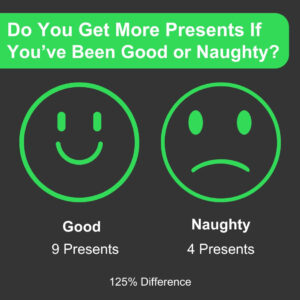It’s Official: Research Reveals Brits Get 5 More Christmas Presents If They’ve Been Good
We’ve all heard it growing up: “If you’re naughty, you won’t get any Christmas presents!” It’s the timeless warning parents have used for generations to keep children on their best behaviour in the run-up to Christmas. Whether it’s the promise of shiny new toys or the threat of a lump of coal in their stocking, this festive tale of morality has become as much a part of the season as mince pies and carol singing. But does being good really pay off in presents? And is there any truth to the idea that Father Christmas – or perhaps your family and friends – reward good behaviour more generously?
To get to the bottom of this Christmas mystery, we at Ivy Casino surveyed 1,000 Brits of all ages to find out if staying on the “nice list” truly leads to a bigger haul under the tree. The results might just jingle your bells!
Here’s what our research discovered:
- On average, good Brits receive 9 Christmas presents, whereas naughty Brits get just 4 presents – a festive 125% increase for those on the “nice” list!
- Women in the UK receive an average of 9 Christmas presents each year, compared to just 7 for men – a gift gap of 29%.
- Brits aged 30-44 get the fewest Christmas presents of any age group, with an average of just 7 gifts per year.
Keep reading to find out more.
Brits Get 5 More Christmas Presents If They’ve Been Good – A 125% Increase

It turns out being on the “nice list” really does pay off. Based on our survey of 1,000 Brits, those classified as “Good” according to their behaviour received an average of 9 Christmas presents, while their “Naughty” counterparts only unwrapped 4 presents. That’s a staggering 125% increase in festive generosity for those who stayed on their best behaviour! It seems the rewards for good deeds go far beyond just a warm feeling of self-satisfaction.
How did we work this out?
We assigned a sentiment score to each respondent’s behaviour based on their answers to questions about their actions and deeds, such as recycling, helping others, and avoiding negative habits. These scores determined whether someone was classified as “Good” or “Naughty,” allowing us to link their behaviour to the number of Christmas presents they received. We list every question in our methodology, but here’s an example:
Example Question: Do you recycle regularly?
| Answer | Sentiment |
| Always | Very Good (+2) |
| Often | Good (+1) |
| Rarely | Naughty (-1) |
| Never | Very Naughty (-2) |
Women Receive 9 Christmas Presents On Average, While Men Only Get 7 Presents – A 29% Difference

It seems the festive season comes with a bit of a gender twist! According to our findings, women in the UK receive an average of 9 Christmas presents, while men only manage to unwrap 7 – marking a 29% difference in festive generosity. Is this a sign that women have been a little nicer this year? Or perhaps they’re simply better at dropping hints for Father Christmas?
Whatever the reason, it’s clear that the gift-giving scales tip in favour of women when it comes to Christmas morning. So, men, if you’re feeling a little short-changed, maybe it’s time to double-check that you’ve made the “nice list” this year!
30–44 Year Olds Get the Lowest Amount of Christmas Presents in the UK

It turns out that age plays a significant role in how many presents end up under the tree! According to our research, those aged 30 to 44 receive the fewest Christmas presents in the UK, with an average of just 7 gifts. On the other hand, the most festive spoils go to 18- to 29-year-olds, who manage to unwrap an impressive 11 presents.
Meanwhile, those aged 45 to 60 and 60+ sit comfortably in the middle, with 9 and 10 presents respectively. Perhaps it’s a sign that the hustle and bustle of the 30s and 40s leave less time for wish lists – or maybe Father Christmas is prioritising the young and young-at-heart this year!
Our Thoughts at Ivy Casino
Here’s the thoughts of Ivy Casino representative Mark Good on our research: “Ivy Casino’s research offers a fascinating glimpse into how our actions can influence not just our relationships but also the festive spirit. It’s heartwarming to see that kindness and positive behaviour are recognised in such tangible ways—even through something as simple as Christmas presents. This data reminds us that the true spirit of the season is about giving, goodwill, and staying on the ‘nice’ list!
Methodology
We conducted a survey of 1,000 Brits aged 18-60+, asking them about their behaviour and how many Christmas presents they received last year. To evaluate their actions, we assigned each response a sentiment—ranging from very good to very naughty—to determine whether their behaviour could be classified as “good” or “naughty.” Each of the survey questions was designed to assess key aspects of kindness, responsibility, and positive habits.
Here’s a full list of the questions we asked about their habits:
- Did you do any volunteer workr?
- Do you recycle regularly?
- Have you helped friends or family with something important?
- Have you followed through on personal goals this year (e.g. exercising or maintaining healthy habits)?
- Have you avoided negative behaviours this year (e.g. pulling sick days, breaking promises, or excessive procrastination)?
- Did you make an effort to show kindness to others this year (e.g. random acts of kindness, compliments)?
- How often do you give to charity?
- How well do you think you maintained a positive attitude and avoided conflicts with others?
- How responsible were you in keeping promises or commitments this year?
And finally…
- How many Christmas presents did you receive last year?
We analysed the data by averaging the number of very good and good responses compared to naughty and very naughty. This allowed us to calculate the difference in the number of presents received between those who had been “good” and “naughty” over the year. Additionally, our findings on age and gender differences were assessed based on the personal characteristics of our respondents.
Looking for more fascinating research and stories? Check out our recent study on the most dangerous UK attractions to drive to during winter months—available now on our blog!
